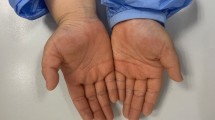Summary
A large variety of methods and a wide range of products from several manufacturers are available for IgE-based in vitro allergy testing. In the large majority of cases, the attending physician lacks information about the devices and products used in the laboratory performing the tests. To determine the comparability and reliability of different laboratories, we analyzed the findings of an international ring trial established in Austria 25 years ago.
The results were satisfactory: 97.4 % of total IgE tests and 93.9 % of antigen-specific IgE tests were correct. Further analysis revealed more false-positive than false-negative antigen-specific IgE levels (17.1 vs. 5.2 %). The investigation of different allergen groups yielded excellent results for some allergens (97.8 % correct values for mites, or 99.6 % correct values for recombinant antigens), but quite unfavorable for others (21.4 % incorrect values for drugs). In view of this paucity of comparability and reliability, it would be appropriate to establish mandatory quality control in laboratories and manufacturing units.
Zusammenfassung
Im Rahmen der IgE-basierten in-vitro Allergiediagnostik stellt sich aufgrund der großen Zahl an technischen Möglichkeiten, anbietenden Firmen und durchführenden Laboratorien für den zuweisenden Arzt die Frage nach der Vergleichbarkeit und Verlässlichkeit der Resultate einzelner Allergene und Allergengruppen. In der vorliegenden Arbeit werden diese Eigenschaften mit Hilfe eines seit 25 Jahren etablierten Ringversuchs untersucht. Es wurden dabei 506 Serumproben an Laboratorien in Österreich und seinen Nachbarländern versandt. Die Resultate waren großteils zufriedenstellend: Insgesamt waren 97,4 % der Gesamt-IgE-Bestimmungen und 93,9 % der antigenspezifischen IgE-Bestimmungen als korrekt zu werten, mittels Aufschlüsselung der inkorrekten antigenspezfischen IgE-Werte waren mehr falsch-positive als falsch-negative Werte feststellbar (17,1 % vs. 5,2 %). Während eine Analyse der einzelnen Allergengruppen zum Teil hervorragende Resultate lieferte (z. B. Milben: 97,8 % der Bestimmungen korrekt, rekombinante Antigene 99,6 % korrekt), waren die Ergebnisse bei anderen sehr ernüchternd (z. B. Medikamente: 21,4 % inkorrekte Ergebnisse). Eine Vergleichbarkeit der Befunde zwischen verschiedenen Laboratorien war häufig, aber bei weitem nicht immer gegeben. Der Forderung einer in vielen Ländern üblichen verpflichtenden Qualitätssicherung sowohl für Firmen als auch Laboratorien wurde trotz mehrmaliger Anregung bis jetzt nicht Folge geleistet.




Similar content being viewed by others
References
Aberer W, Kränke B. Measurement of IgE antibodies using liquid allergens—an inter-method and inter-laboratory quality assessment. Wien Klin Wochenschr. 2002;144:929–37.
Hamilton RG, Williams PB. Specific IgE testing task force of the AAAAI, ACAAI. Human IgE antibody serology: a primer for the practicing North American allergist/immunologist. J Allergy Clin Immunol. 2010;126:33–8.
Aberer W, Kränke B, Hager A, Wick G. In vitro allergy testing needs better standardization-test results from different laboratories lack comparability mostly due to missing effective standards. Int Arch Allergy Immunol. 1995;108:82–8.
Aberer W, Ebner H, Horak F, et al. Qualitätskontrolle im Allergielabor—4 Jahre „Ringversuch Allergie“ in Österreich. Wien Klin Wochenschr. 1992;104:195–9.
Sturm GJ, Kranzelbinder B, Schuster C, et al. Sensitization to Hymenoptera venoms is common, but systemic sting reactions are rare. J Allergy Clin Immunol. 2014;133:1635–43.
Eigenmann PA, Oh JW, Beyer K. Diagnostic testing in the evaluation of food allergy. Pediatr Clin North Am. 2011;58:351–62.
Sanz ML, Prieto I, García BE, Oehling A. Diagnostic reliability considerations of specific IgE determination. J Investig Allergol Clin Immunol. 1996;6:152–61.
Renz H, Biedermann T, Bufe A, et al. In-vitro-Allergiediagnostik—Leitlinien der Deutschen Gesellschaft für Allergologie und Immunologie. Allergo J. 2010;19:110–28.
Thong BY, Mirakian R, Castells M, et al. A World Allergy Organization international survey on diagnostic procedures and therapies in drug allergy/hypersensitivity. World Allergy Organ J. 2011;4:257–70.
Rueff F, Vos B, Przybilla B. In-vitro-Diagnostik bei Insektengiftallergie. Allergologie. 2013;36:43–50.
Bilo BM, Bonifazi F. Epidemiology of insect venom anaphylaxis. Curr Opin Allergy Clin Immunol. 2008;8:330–7.
Kleine-Tebbe J, Fuchs T, Lepp U, et al. In-Vitro-Diagnostik von Nahrungsmittelallergien. Allergo J. 2001;10:333–9.
Aalberse RC, Akkerdaas J, van Ree R. Cross-reactivity of IgE antibodies to allergens. Allergy. 2001;56:478–90.
Altmann F. The role of protein glycosylation in allergy. Int Arch Allergy Immunol. 2007;142:99–115.
Aberer W, Holzweber F, Hemmer W, et al. Inhibition kreuzreaktiver Kohlenhydratdeterminanten (CCDs) erhöht die Treffsicherheit der In-vitro-Allergiediagnostik. Allergologie. 2014;2:46–54.
Canoncica GW, Ansotegui IJ, Pawankar R, et al. A WAO-ARIA-GA2LEN consensus document on molecular-based allergy diagnostics. World Allergy Organ J. 2013;6:17.
Wang J, Godbold JH, Sampson HA. Correlation of serum allergy (IgE) tests performed by different assay systems. J Allergy Clin Immunol. 2008;121:1219–24.
Sampson HA. Utility of food-specific IgE concentrations in predicting symptomatic food allergy. J Allergy Clin Immunol. 2001;107:891–6.
Contin-Bordes C, Petersen A, Chahine I, et al. Comparison of ADVIA Centaur and Pharmacia UniCAP tests in the diagnosis of food allergy in children with atopic dermatitis. Pediatr Allergy Immunol. 2007;18:614–20.
Acknowledgments
We thank all laboratories involved in the study for their many years of excellent cooperation, in particular: Allergieambulatorium Burgenland (J Mikschi), Allergieambulatorium Wien-Mitte (D Blagojevic), Allergieambulatorium Wien-West (F Horak), Allergielabor dermatologische Abteilung Wilhelminenspital Wien (W Jurecka), Allergielabor Univ.-Hautklinik Innsbruck (N Reider), Allergielabor LKH Villach (B Sterz), Allergieambulatorium Hall i.Tirol (H Kofler), Gruppenpraxis Labors.at Wien (K Bertl, M Exner), HYCOR Europe (S Staten), IASON Gmbh (M Resch), Immunologisches Labor Univ.-Hautklinik Salzburg (G Pohla-Gubo), Labordiagnostik mit Blutbank, Wien (A Haushofer), Nuklearmedizin AKH Linz (M Gabriel), Nuklearmedizin und Endokrinologie Elisabethinen Linz (J Dierneder), Klinikum Bad Gleichenberg (M Trinker), Klinikum Klagenfurt-Wörthersee (P Sinha), Diagnostisches Labor Innsbruck (G Wick), Landes-Frauen-/Kinderklinik Linz (Schreier-Lechner), Labordiagnostik Klagenfurt (F Holzweber), MEDIWISS Analytic GmbH Deutschland (P von Wahl), Medizinisches Labor Klagenfurt (J Perné), Phadia Austria GmbH (P Forstenlechner), Zentrallabor Kardinal Schwarzenberg'sches Krankenhaus (B Auer), Zentrallabor SMZ Baumgartnerhöhe (W Hübl).
Conflict of interest
Lukas Koch and Werner Aberer declare that there is no conflict of interest.
Author information
Authors and Affiliations
Corresponding author
Rights and permissions
About this article
Cite this article
Koch, L., Aberer, W. Comparability and quality of IgE-based in vitro allergy diagnosis: 25 years of external quality assessment. Wien Klin Wochenschr 126, 634–641 (2014). https://doi.org/10.1007/s00508-014-0594-5
Received:
Accepted:
Published:
Issue Date:
DOI: https://doi.org/10.1007/s00508-014-0594-5




